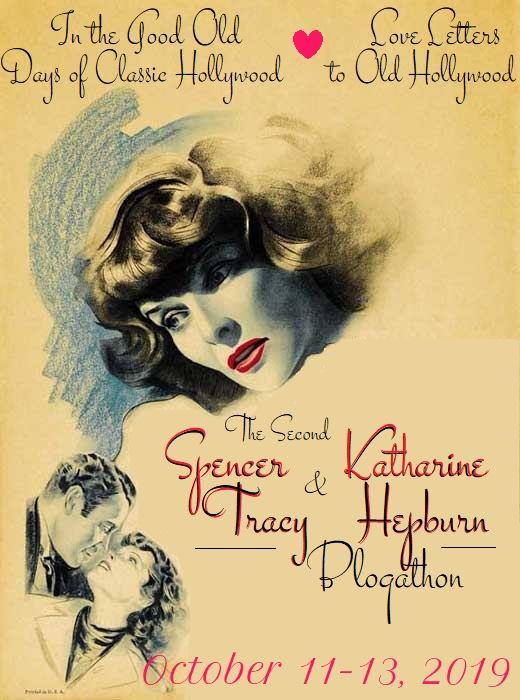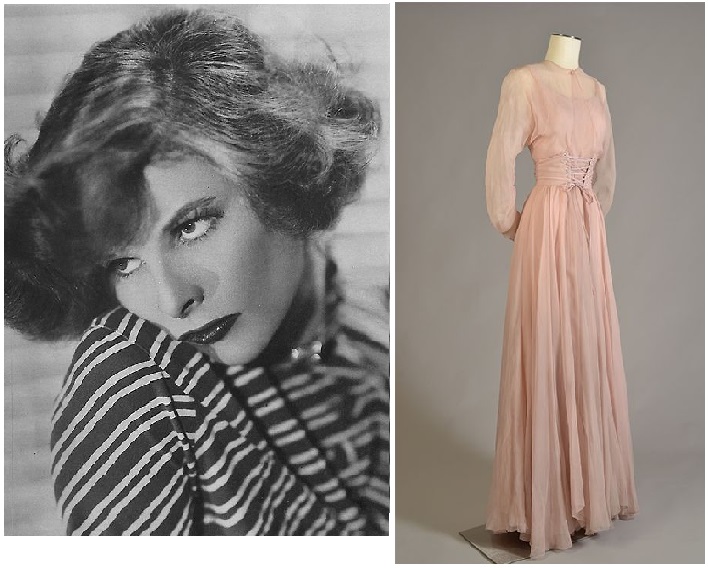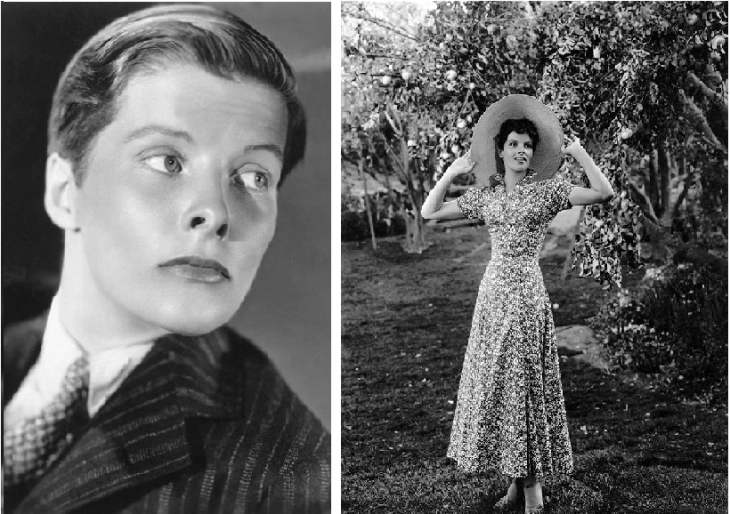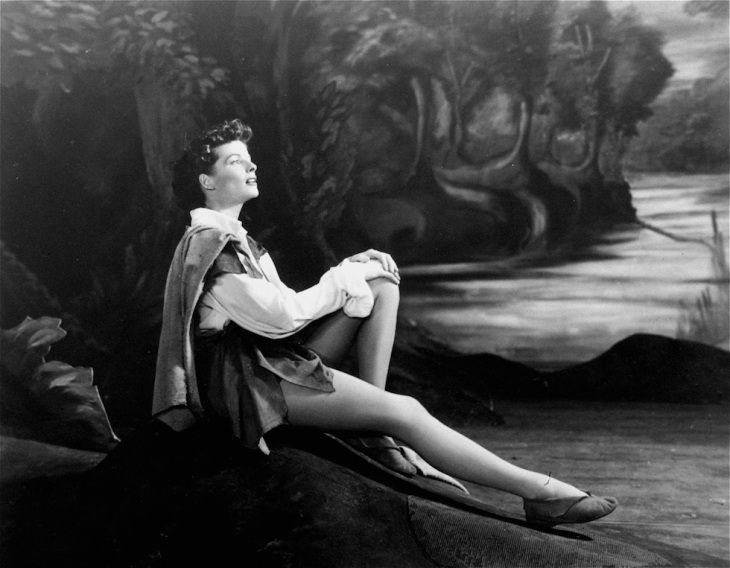I’m back at it again with another blogathon. This time, it’s one which celebrates all things Katharine Hepburn and Spencer Tracy. The blogathon is hosted by In the Good Old Days of Classic Hollywood and it is taking place over the weekend of the 11th-13th. My contribution, however, is specifically looking at Katharine Hepburn and her fashionable looks on and off screen.

My interest in Katharine Hepburn’s costume choices in films and fashion in general came about during the writing of my dissertation. I was looking for another case study to contrast with my first which was Vivien Leigh. My advisor suggested Katharine Hepburn, as she is someone who is seen as the complete opposite of Leigh’s lady-like grace and glamour. In fact, the reason most people see Katharine Hepburn as a fashion icon because she seemed to not care about others opinions around what she was wearing. She is someone who is was independent, headstrong, tomboyish and so ahead of her time when it comes to her fashion choices. She was, is and will always be considered an American fashion icon.
She became a champion for American design and yet people also probably still believe that she didn’t really care for fashion at all. When I started doing research for my dissertation, I came across something very interesting indeed. Something so interesting that it made me rethink the way that I look at Katharine Hepburn’s relationship to fashion.
Sometime in the 2010’s, the Kent State Museum in Ohio, USA acquired the warehouse that was filled with Hepburn’s performance clothes. Her clothes were in storage in Connecticut and it was home to 1,000 pieces. They acquired everything from her fake eyelashes, pan cake make-up, her wigs and wiglets and most importantly her personal collection of performance clothes. The collection has pieces throughout her career, from the play ‘The Lake’ (1933) right up until the later films that she was working on in the 1990s. When making the mannequins to place her clothes on for display, they realised that they had to extremely alter the mannequins to fit her measurements. Her measurements didn’t really change that much through the ages, however, when she was younger her waist size was 20 1/2 inches! (It seems that this Hepburn, much like Audrey, had a tiny figure too.) Her ribcage was 23” and she was 5’7. These pieces make up the ‘Katharine Hepburn: Dressed for Stage and Screen’ exhibition which is still touring today. At the time of writing, it’s on at The Frick in Pittsburgh, USA.

On the left is a young Katharine Hepburn who the R.K.O executives tried to mould into the image of other stars at the time, like Greta Garbo. On the right is a costume from the Kent Museums collection. It is the original dress from ‘The Philadelphia Story’ stage production. She also wore this dress in the 1973 TV drama, ‘The Glass Menagerie’.
A clothes collection from the Studio era is quite rare to have, as that time there was no budget or any facility which allowed studios to keep these things. At the end of the day they had a budget to work with, and like with all budgets, costuming is always put towards the bottom end of priorities. I found this really interesting as her image extremely contradicts what was actually going on behind the scenes. In reality, Hepburn became extremely conscious of her style and using it to work in her favour. She had an acute understanding of what look good on her, and like her contemporary Bette Davis, she was interested in using clothes to help define the characters that she was playing. She had an affinity for designers Walter Plunkett and Valentina and she became a champion of the newly developing American style of the 1940s. She was awarded a Lifetime Achievement Award from the Council of Fashion Designers of America in 1985, along with being a 12 Oscar nominee. Katharine Hepburn worked really hard to keep up her image throughout her life and it must have worked, otherwise we still wouldn’t be here talking about her today.
When she first started her film and theatre career, however, her distinct style was never really in place. During the first screenings for her first picture with R.K.O, ‘A Bill of Divorcement’ (1932) the pictures producer David O. Selznick recalled “you could feel the audience’s bewilderment at this completely new type and also feel that they weren’t quite used to this kind of face.” At a tall 5 foot 7, Hepburn was unlike any of her other contemporaries at the time. Her frame was slender, model-like and a very particular face, with high cheekbones and very jarring features. Actresses like Jean Harlow and Carol Lombard were both smaller in height, blonde and they had more rounded and feminine features. Katherine was someone who was very blunt in both words and figure and someone who was educated with a degree from Bryn Mawr. She was a complete departure from any other Hollywood actress at that time. In fact, from the moment Katharine Hepburn first arrived in Hollywood she was still the lanky tomboy who would get bouts of acne caused by stress. When Myron Selznick first saw Hepburn arrive off the train to meet with R.K.O executives and George Cukor he exclaimed “the studio is paying $1,500 a week for that?”
The studio system, at that time, was still strong in its place. Hollywood did, and unfortunately still does, look towards the looks of an actor or actress possessed and how well would that transfer onto the screen. The emphasis upon looks was something which most probably transpired from the silent era, when facial expressions were key. In the late 20s ‘talking pictures’ became all the range following the success of ‘The Jazz Singer’ and the stars of the day were still extremely popular, even though they were no longer making pictures. By the 1930s, Hollywood films were changing in a different direction and they needed stars to reflect that change. They needed someone modern and independent. They needed Katharine Hepburn.
The development of Katharine Hepburn as the woman we all know and love would take time to develop onto our Hollywood screens. Years later, she was asked what was considered wrong with her during the early 30s and she responded with “practically everything”. Photos taken of her during the early 30s show how the studio tried to mould her into their image. She played along with the studios efforts to make her into another Garbo but the problem with that was she wasn’t ‘exotic’ or mysterious, in fact she was an American woman who could be very forthcoming. “I let them make me up and then I took all that makeup off and I presented what I thought was the true me” she once said and that she did, considering that the only makeup she usually wore outside of work was lipsticks and false eyelashes.

Both pictures are from the 1935 film, ‘Sylvia Scarlett’. The film highlighted Hepburn’s ability to blur between, and somewhat reinforce gender lines. On the left as Sylvester and on the right as Sylvia.
But this idea of ‘playing along with the studio executives’ hardly lasted at all, especially considering her next film ‘Christopher Strong’ (1933). Her role in this picture is as Lady Cynthia Darrington, a female pilot reminiscent of Amelia Earhart. Roles she had in the 30s like Jo March in ‘Little Women’ (1933), Sylvia Scarlett in ‘Sylvia Scarlett’ (1935) and Mary Stuart in ‘Mary of Scotland’ (1936) all symbolise the types of roles Hepburn would become entangled with through the rest of her life. Even though in these films her makeup is very much on show, her costumes bring out the masculine, independent spirit of Katharine Hepburn. This is especially prevalent in ‘Sylvia Scarlett’ when she disguises herself as Sylvester Scarlett. In fact, this film is very symbolic of the very roles she would be playing in the 40s and 50s too.
Just like her contemporary Marlene Dietrich, Hepburn’s style was symbolic of what was at the time a questionable fashion choice for a young lady. The androgynous style worked extremely well for Hepburn’s figure, as if you look at the publicity shots for this film, it becomes questionable as to whether or not she was actually a man. Sylvester’s wearing of suits and ties symbolises Hepburn’s ability to blur the lines between masculine and feminine dress, a trait which was symbiotic with her own proto-feminist views. Yet at the same time the plot seems to contradict the stance of Sylvester and instead play into the hands of patriarchal views. This whole film creates this whole stereotypical contradiction with Sylvia, who wears dresses and falls in love with a guy named Michael Fane (Brian Aherne).
Within her film career, this approach to the films plots seemed to always undermine the work of the rebellious and independent characters that Hepburn played. For example, even though she always wore trousers in the 30s they weren’t completely unacceptable at the time. If someone was to wear trousers on a private garden estate, just like Hepburn’s Susan in ‘Bringing up Baby’ (1938) was during a scene looking for David’s bone, it was considered acceptable by the various etiquette magazines. This was even more apparent after her ‘box office poison days’ through her roles in ‘The Philadelphia Story’ (1940) and her various films with Spencer Tracy. In most of these films she wore more dresses, tailored feminine suits and fell in love with men. This never did stump Hepburn’s image as the independent, forward thinking and rebellious spirit that she was for two reasons. One, just like the audience she knew it was all make believe and two, she was always involved in the process of carefully constructing her costumes.
The costume designer Edith Head once remarked that “one designs with her. She’s a real professional, and she has very definite feelings about what things are right for her, whether it has to do with costumes, scripts or her entire lifestyle.” She worked with designers to help create her definitive style. The ‘Hepburn’ style was an American one where she could be glamorous in couture gowns, and glamorous within comfortable sports-style wear. During the collaborative process of working with designers, she would begin researching and sketching around seven months before rehearsals even started which was helpful to her process of characterisation. This became ever so present during her run in the Shakespearean plays that she performed during the mid-to-late 1950s. Within her scripts and the wardrobe bibles of shows such as ‘Much Ado About Nothing’ and ‘Twelfth Night’, she would make notes around the costumes and their colours, something which I have seen myself when going through the archival material at the V&A Museum. This systemic note taking highlights the determined will that Hepburn brought to her roles and the intelligent and minute detail that she would research when taking on her roles.

Katharine Hepburn as Rosalind in a stage production of ‘As You Like It’ (1950.) This stage show, like her other Shakespearean productions had the annotations in the costume section of things like ‘green tights’. (As seen in the V&A archives.)
Even during her early days in theatre productions, she had to bring in her own contemporary clothes for the character that she was playing. As much as Hepburn may have disapproved of the Hollywood system she knew that she had to play the game to succeed in it. Throughout her sixty-year career of both stage and screen, she understood the power of clothes herself. After all, she took great pride in them whilst declaring that “I wear my sort of clothes to save me the trouble of deciding which clothes to wear.” Her own personal wardrobe was one that was curated with personal comfort in mind. Before this time, the idea of creating a woman’s wardrobe with comfort taking prevalence was not really a thing. Her preferred outfits were man-tailored suits, high-waisted and loose trousers, overcoats that had roomy armholes along with cardigans and turtlenecks. She was very much against the way women dressed during her time. “No matter how free women get”, Hepburn once said, “they always seem to be tied into asinine clothes… I hate to see women a victim of things which to me are totally silly.”
By the time she died in 2003 at the age of 96, Hepburn’s fashion would inform and influence fashion even today. Her style became extremely influential to the women of everyday America who were able to wear and express themselves with more comfortable and sporting clothing. Her consistent wearing of trousers may have annoyed others at the time, but her looks on and off screen has inspired thousands of women around the world today. Her style elevated American designers such as Elizabeth Hawes into the spotlight, helping to elevate America into the fashion powerhouse that it is today. The control that she had over her image on and off-screen provided another way that women could observe, and aspire to. Always one to define convention, she was asked by Barbara Walters during one of her last interviews, “Do you ever wear a skirt, by the way?” Hepburn responded with “I have one. I’ll wear it to your funeral.
……………………………………………………………………………………………………………………………………………………..
If you are interested to learn more about Katharine Hepburn and fashion, I would recommend that you get the Rebel Chic book which accompanies the Dressed for Stage and Screen exhibit. If you’re also interested, I did write a little book review about one of Kathrine Hepburn’s biographies here. I also recommend that everyone check out ‘Bringing up Baby’ because it’s hilarious as well as the exhibit on Katharine Hepburn’s fashion which I wish would come to the UK someday.

Thank you for the fascinating food for thought regarding Hepburn and fashion.How remarkable that she could wear the same dress in the 1970s that she wore on stage in 1940!
-Caftan Woman
LikeLiked by 1 person
Thank you for reading and I’m glad that you enjoyed my piece.
😊
Her measurements hardly ever changed during her lifetime most probably due to all of that exercise she was doing. I hope I can fit into a dress like that in 30 years too.
LikeLike
Such a fascinating article. I learned so much about my favorite actress and her style. Thank you so much for sharing!
LikeLiked by 1 person
Thank you for reading and I’m glad that you learnt something new. 😊 If you want to learn even more than this I recommend that you get a copy of the ‘Katharine Hepburn: Rebel Chic’ book which I mentioned in my piece.
LikeLike
I’ve added it to my Amazon list.
LikeLiked by 1 person
Kate’s fashion is part of why I love her so much and your piece did a wonderful job in explaining how it was so unique and thoroughly her. I have a pretty big aversion to skirts and dresses myself, which made me feel like an odd duck until I discovered Kate and realized we had that in common. Now if only I had her figure…
Thanks for contributing this fabulous piece to our blogathon!
LikeLiked by 1 person
Thank you for your kinds words I extremely appreciate it. 😊 Trust me, you are not the only one who wishes that they had her figure.
LikeLiked by 1 person
Dear Genevieve,
This is a very interesting article about Katharine Hepburn’s fashion. She certainly wore a lot of lovely costumes in the films I’ve seen with her, including her black New Year’s Eve dress in “Holiday.”
By the way, PEPS is hosting two upcoming blogathons, The Second Annual Claude Rains Blogathon on November 8-10 (https://pureentertainmentpreservationsociety.wordpress.com/2019/10/18/round-up-the-usual-suspects-the-second-annual-claude-rains-blogathon-is-coming/) and The Happy Holidays Blogathon on December 6-8 (https://pureentertainmentpreservationsociety.wordpress.com/2019/10/22/announcing-the-happy-holidays-blogathon/). We would love for you to join one or both! We think that they will be a lot of fun!
Joyfully,
Rebekah Brannan
LikeLike
Rebekah,
Thank you for reading my post and I’m glad that you found it interesting. 😊 I haven’t actually seen ‘Holiday’ yet although I think I know which dress you are referring to.
Thank you for also letting me know about the blogathons that you are hosting. I’ll have a think and if I have any ideas on what I could write about then I will get back to you.
LikeLiked by 1 person